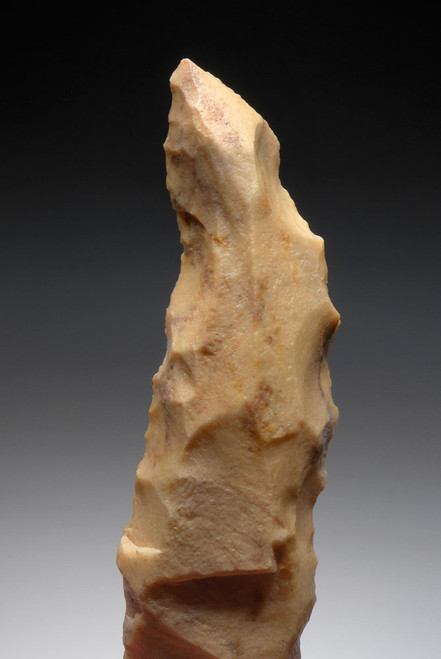Product Description
For comparison prices, please see the "Old World Typology and Price Guide" section of the "OVERSTREET IDENTIFICATION AND PRICE GUIDE TO INDIAN ARROWHEADS" editions 7th, 8th and 9th.
SEE MORE AFRICAN MIDDLE STONE AGE TOOLS
This rare and unique red and gold quartzite biface hand axe was found in the Sahara Desert of Libya, and dates to the Middle Stone Age (MSA), between 280,000 and 50,000 years ago. It was made by either anatomically modern humans (Homo sapiens), or archaic Homo sapiens. Because of the past dangers of navigating the Libyan desert, and the laws forbidding artifact export, Paleolithic tools from Libya are extremely scarce. This is an exclusive offering being one of only a few stone tools we acquired from an old Dutch collection. Once sold, we will never have any others to offer again.
This Middle Stone Age artifact is a LANCEOLATE BIFACE HAND AXE. Of the small and very rare collection it came from, it was THE ONLY hand axe, the remainder were flake tools. Most certainly a prestige tool from a masterful artisan toolmaker, the genius, artistic orientation of the red portion of the stone to make the sharp tip was no coincidence! This is the only portion of the hand axe that is red! The remainder is gold and the entire form is the most exquisitely flaked and shaped biface in quartzite we have seen. Quartzite is extremely tough to work and flake on a refined level, making this investment-grade prehistoric artifact all the more rare and impressive. The side profile photos show just how amazingly thin and fine the tip is. What is truly impressive is that such a thin and delicate tip survived INTACT! Similar to the shrinking sizes of bifaces in the European Middle Paleolithic, this hand axe was likely made towards the end of the Middle Stone Age. It is complete with superb preservation and workmanship typical of the Middle Stone Age of Africa. It features a deep patina called 'desert varnish' which is a smooth, glossy surface layer consisting of iron oxide and manganese deposited over thousands of years by exposure to blowing desert sand.
HISTORY
The Middle Stone Age (or MSA) was a period of African prehistory between the Early Stone Age and the Late Stone Age. It is generally considered to have begun around 280,000 years ago and ended around 50–25,000 years ago. The beginnings of particular MSA stone tools have their origins as far back as 550–500,000 years ago and as such some researchers consider this to be the beginnings of the MSA. The MSA is often mistakenly understood to be synonymous with the Middle Paleolithic of Europe, especially due to their roughly contemporaneous time span, however, the Middle Paleolithic of Europe represents an entirely different hominin population, Homo neanderthalensis, than the MSA of Africa, which did not have Neanderthal populations. Additionally, current archaeological research in Africa has yielded much evidence to suggest that modern human behavior and cognition was beginning to develop much earlier in Africa during the MSA than it was in Europe during the Middle Paleolithic. The MSA is associated with both anatomically modern humans (Homo sapiens) as well as archaic Homo sapiens.
The stone tool technology in use during the Middle Stone Age (MSA) shows a mosaic of techniques. Beginning approximately 300 kya, the large cutting tools of the Achuelian are gradually displaced by Levallois prepared core technologies, also widely used by Neanderthals during the European Middle Paleolithic. As the MSA progresses, highly varied technocomplexes become common throughout Africa and include pointed artifacts, blades, retouched flakes, end and side scrapers, grinding stones, and even bone tools. However, the use of blades (associated mainly with the Upper Paleolithic in Europe) is seen at many sites as well. In Africa, blades may have been used during the transition from the Early Stone Age to the Middle Stone Age onwards. Finally, during the later part of the Middle Stone Age, microlithic technologies aimed at producing replaceable components of composite hafted tools are seen from at least 70 ka at sites such as Pinnacle Point and Diepkloof Rock Shelter in South Africa.
 US DOLLAR
US DOLLAR
 EURO
EURO
 AUSTRALIAN DOLLAR
AUSTRALIAN DOLLAR
 CANADIAN DOLLAR
CANADIAN DOLLAR
 POUND STERLING
POUND STERLING


























